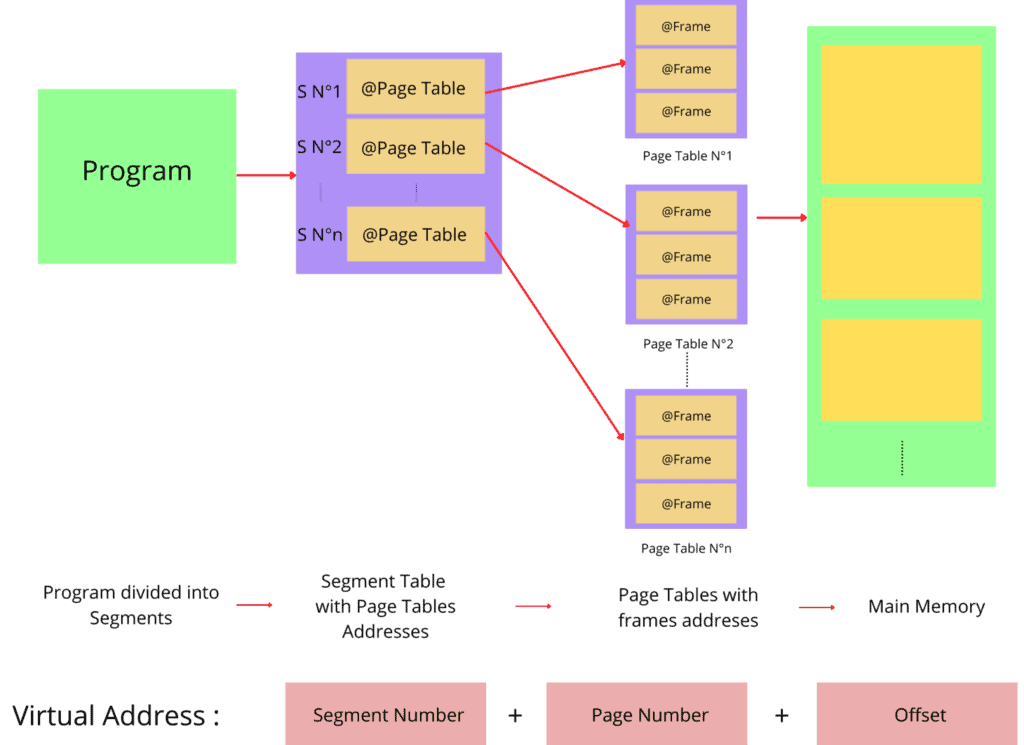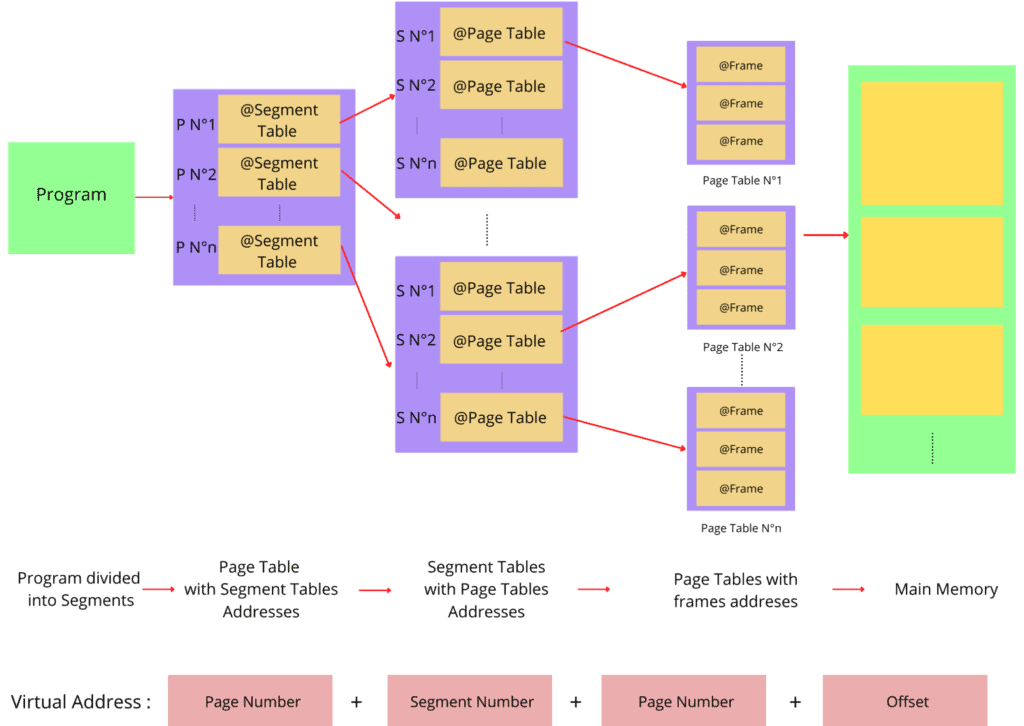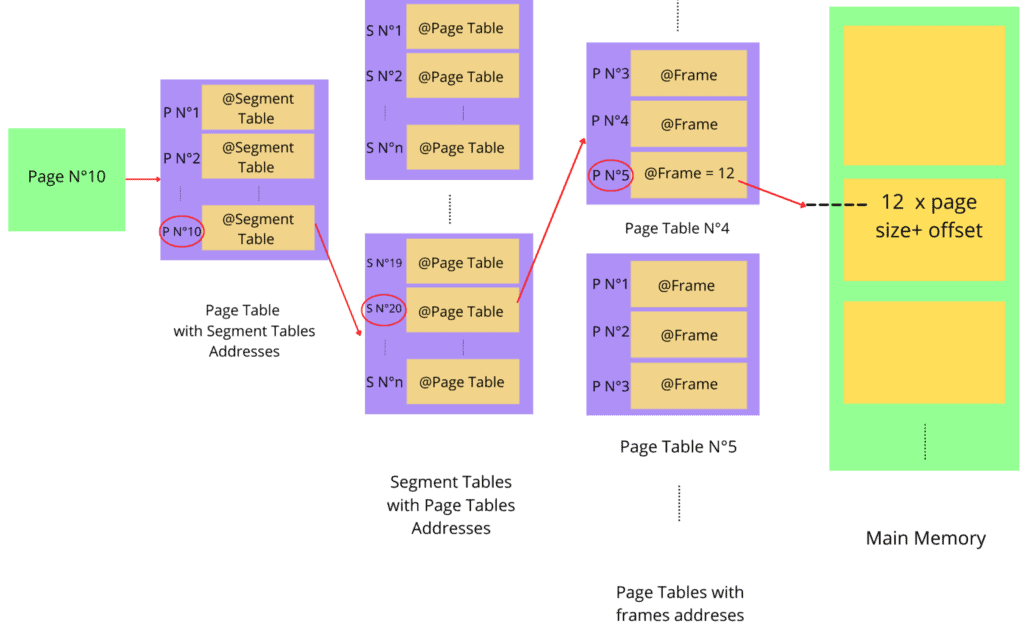1. 概述
在本篇文章中,我们将深入探讨两种主流的非连续内存分配技术:Segmented Paging(分段分页) 与 Paged Segmentation(分页分段)。我们会分别讲解它们的工作机制、优缺点,并通过示例说明其地址转换过程。
最后,我们还会对比这两种技术的核心差异,帮助你更好地理解它们在内存管理中的实际应用。
2. 背景与动机
现代程序日益复杂,对内存的需求也越来越大。为了提升内存使用效率,操作系统引入了虚拟内存和分页机制。但随着逻辑地址空间的扩大,页表(Page Table) 占用的内存也会急剧增加,这成为内存管理中的一个瓶颈。
为了解决这个问题,研究人员提出了结合分段(Segmentation)和分页(Paging)的混合策略。本文将重点介绍其中的两种实现方式:Segmented Paging 和 Paged Segmentation。
3. Segmented Paging(分段分页)
Segmented Paging 是将分段与分页结合使用的一种技术,目的是减少页表在内存中的占用空间。
3.1. 基本原理
- 分段:将程序划分为多个逻辑段(如代码段、数据段、堆栈段等)。
- 分页:每个段再进一步划分为固定大小的页。
- 段表(Segment Table):记录每个段对应的页表地址。
- 页表(Page Table):记录页对应的物理帧地址。
这样,每个逻辑地址由三部分组成:
✅ 段号(Segment Number)
✅ 页号(Page Number)
✅ 页内偏移(Offset)

3.2. 示例说明
假设我们有一个程序,包含两个段:函数段(A)和数据段(B)。段表中分别记录了这两个段的页表地址。
例如,逻辑地址为 (A: 5, 1, 20),表示:
- 段 A(Segment 5)
- 页号 1
- 偏移 20
物理地址计算为:
$$ pa = 515 \times page_size + 20 $$

3.3. 优缺点分析
| 优点 | 缺点 |
|---|---|
| ✅ 减少页表大小 | ❌ 顺序地址转换导致访问延迟 |
| ✅ 避免外部碎片 | ❌ 硬件实现较复杂 |
| ✅ 内存分配更简单 | ❌ 页表必须连续存储 |
4. Paged Segmentation(分页分段)
Paged Segmentation 的核心思想是将段表本身也进行分页,从而进一步减少段表在内存中的占用。
4.1. 基本原理
- 段表分页:将段表划分为多个页,每个页对应一个页表。
- 地址结构:包含四个字段:
- 页面号(Page Number)
- 段号(Segment Number)
- 页表页号(Second Page Number)
- 偏移(Offset)

4.2. 示例说明
考虑一个程序包含三个段 A、B、C。逻辑地址为 (C: 10, 20, 5, 949),表示:
- 第 10 页的页表中查找段 C 的页表地址
- 从该页表的第 20 项中获取对应的页表地址
- 在该页表的第 5 项中找到物理帧地址
- 最后加上偏移 949 得到物理地址
最终物理地址为:
$$ pa = 12 \times page_size + offset $$

4.3. 优缺点分析
| 优点 | 缺点 |
|---|---|
| ✅ 消除外部碎片 | ❌ 存在内部碎片风险 |
| ✅ 减少段表大小 | ❌ 地址转换延迟更高 |
| ✅ 内存利用率更高 | ❌ 硬件实现更复杂 |
5. 核心差异对比
| 特性 | Segmented Paging | Paged Segmentation |
|---|---|---|
| 分段方式 | 段被分页 | 段表也被分页 |
| 地址结构 | 段号 + 页号 + 偏移 | 页号 + 段号 + 页号 + 偏移 |
| 硬件复杂度 | 较低 | 较高 |
| 可能碎片类型 | 外部碎片(概率低) | 内部碎片(概率低) |
| 页表结构 | 每个段一个页表 | 每个段表一个页表 |
6. 总结
尽管分页和分段各自都有一定的优势,但它们也带来了内存碎片的问题。为了缓解这一问题,结合分段与分页的混合技术被提出,其中:
- Segmented Paging 更适合减少页表大小,但存在外部碎片风险
- Paged Segmentation 进一步优化段表结构,减少内存占用,但实现更复杂
理解这两种技术的差异,有助于我们在设计操作系统或虚拟内存机制时做出更合理的选择。在实际应用中,根据系统需求和硬件能力选择合适的策略,才能实现高效、稳定的内存管理。